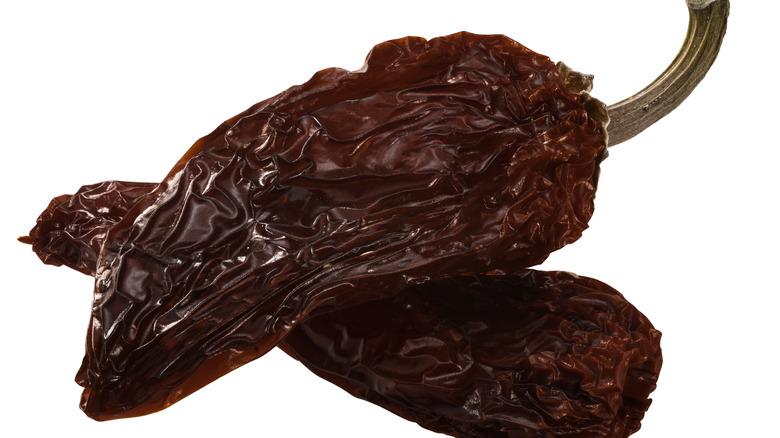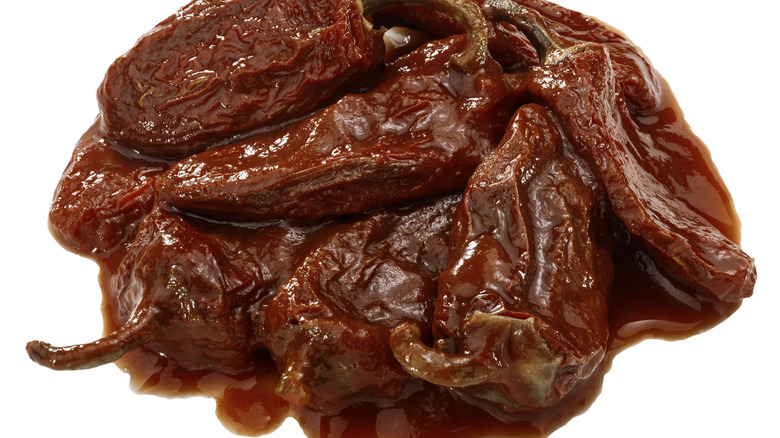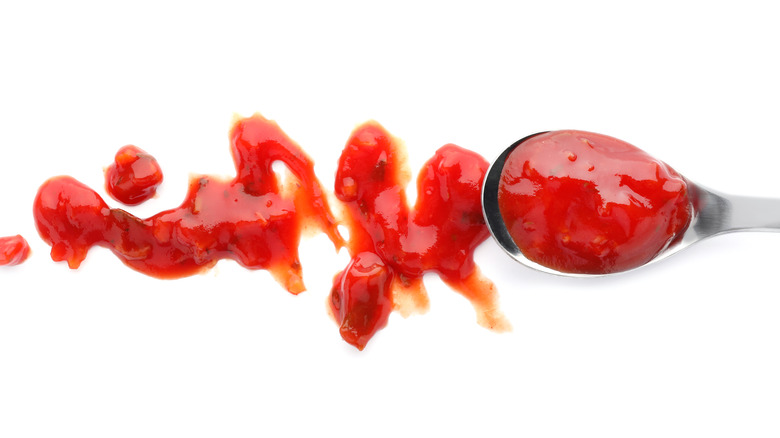Canned Chipotles Vs. Chipotle Paste: What's The Difference?
Thanks to Chipotle Grill, this chile's name is a household word. Many of us are fans of using the version bathed in adobo sauce in everything from cocktails to vegan chili, and if you love the spicy, smoky goodness of chipotle in adobo but not the mess, good news: You can pump up the heat with a squirt of chipotle paste from a tube.
For those whose sole familiarity with chipotle is a burrito bowl, a chipotle chile is a ripe, red, smoke-dried jalapeño pepper. In "The Essential Cuisines of Mexico," Dianna Kennedy tells us that chipotle's original Nahuatl name, chilpectli, means in essence, "smoked chile." You can buy dried chipotle chiles, but we most often see them canned in adobo sauce. It stands to reason that since chipotles are jalapeños, they are equally spicy. But, Pepperscale tells us that though they have the same range of heat, 2,500 to 8,000 heat units on the Scoville scale, the chiles reach their peak levels of capsicum when ripe. Thus, red jalapeño is hotter than green jalapeño.
Whether chipotle is a staple in your kitchen or you're new to it, let's have a look at the options.
Canned chipotles in adobo
According to Diversivore, there are two types of chipotles: meco and morita. Mecos are smoked longer, so they are darker in color and smokier-flavored than moritas. Moritas are similar in color to a purple eggplant. They have a fruity flavor, though they are still smoky and spicy. As with most foods, there's a debate. Dianna Kennedy says in "The Essential Cuisines of Mexico" that moritas are made with the last harvest of chile serrano. But, most agree that canned chipotle is made with chile morita (per Spices Inc.).
Canned chipotles come in adobo, a tomato and vinegar-based sauce with onion, sugar, and spices (per Goya). They are usually whole. Recipes will often use an entire chile as a measurement. It's convenient for some, but less fire-breathing eaters might find it challenging to use an entire can before the chipotles grow mold. To avoid wasting them, Eat Something Vegan suggests blending the chiles in their sauce and freezing portions in ice cube trays for a later date. If that sounds like too much work, a tube of chipotle paste may be a better option for you.
How to use chipotle paste
Chipotle paste comes in a tube, just like anchovy or tomato paste, with the same promise of convenience and longevity. No need to dig a slippery chile out of the can and chop it, and a tube of Olo's Chipotle Paste, for example, will stay fresh in the refrigerator for three months after opening. In comparison, Still Tasty tells us the canned chiles are good for one to two months when appropriately repackaged. If you're not inclined to eat chipotles regularly, the tube might be your best bet.
But be aware that this condiment is different from chipotles in adobo. It's essentially pureed chipotles, preserved with salt and citric acid. As you can imagine, it doesn't taste the same as the chiles in adobo. But, if you want a pure, smoky, spicy chipotle flavor, it's a great option.
Another advantage of using tubed paste over whole canned chiles is the smooth texture. You can squeeze a drop on top of anything, a dollop on a deviled egg, a squiggle in your ramen. No chopping, no seeds, and no need to incorporate the sauce.
Tinned or tubed?
So, should you choose canned chipotles or chipotle paste? That depends on you, your tastes, and your purposes. The main thing to consider is whether you want a straight-up smoky flavor or a more complex smoky, spicy chile with some acidity. Are ease and longevity more important to you than complex flavors and the two-for-one chiles and sauce you get with the canned chipotles? Also, consider that some recipes call specifically for the adobo sauce in addition to the chopped chiles.
Tessa Lowe, the creator of Olo's Chipotle Paste, tells The Speciality Foods Association that 2 teaspoons of the all-natural chipotle paste can substitute for one chipotle chile. She came up with the concept for the product to streamline her cooking time after the birth of her son Owen, and to solve the prevalent problem of half-used cans of chipotles. She named her waste-reducing condiment Olo — her son's nickname. Thanks, Tessa! It seems like a win-win to us. We still have the tried and true chipotles in adobo and now a convenient, long-lasting alternative.



